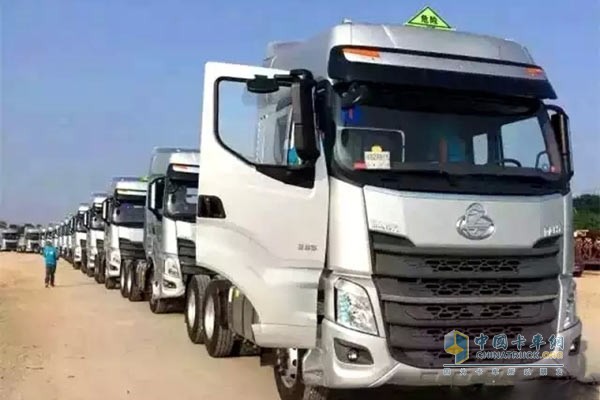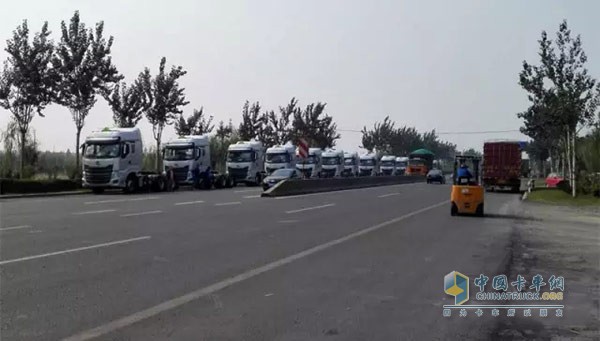Recently, with 20 Dongfeng Liuqi H7 vehicles arriving in Binzhou, Shandong Province, Liuzhou High-end Logistics Vehicle has also successfully entered the curtain of Shandong Dangerous Chemical Market. At the same time, this is the first batch of 50 H7 orders from a logistics company in Binzhou. For vehicles, these 50 orders all match the Dongfeng Cummins ISL9.5 385E40A engine .

The 50 H7 of a logistics company in Binzhou all match Dongfeng Cummins ISL9.5 385E40A engine
According to the author's understanding, the Binzhou logistics company currently owns more than 500 vehicles. However, with the gradual improvement of environmental protection regulations and the strict management of the relevant provisions of the strict control of dangerous goods overload, some vehicles of the company are facing a new replacement cycle. Dongfeng Cummins actively cooperates with Dongfeng Liuzhou Automobile and repeatedly visits the logistics company and takes A number of vehicle update matching schemes were coordinated with the various logistics company's update requirements, and finally reached a consensus.
In early September 2015, the logistics company purchased 50 Dongfeng Liuzhou Auto H7 dangerous goods models equipped with the Dongfeng Cummins ISL9.5 385E40A engine at one time. This is also the largest customer order after Dongfeng Liuqi H7 is listed. Dongfeng Liuqi and Dongfeng Cummins have also attached great importance to this, and formed a special service guarantee team for the logistics company H7 model, as well as from the car, production, transportation, Delivery, after-sales service, etc., jointly formulated a detailed work plan for the delivery of a sufficient protection.

On October 2, the first batch of 20 Dongfeng Liuqi H7 set off to Shandong Binzhou
On October 2, 2015, the first batch of 20 Dongfeng Liuqi H7 departed for transportation to Binzhou, Shandong Province. In order to ensure the normal operation of the vehicles, Dongfeng Cummins and Dongfeng Liuzhou Automobile will be stationed in Binzhou in advance to conduct preliminary vehicle preparation for dealers and logistics companies. Driver preparation, technical support for service providers, spare parts reserve and other preparations ensure that the vehicles can enter the operating state at any time.
Dongfeng Liuqi and Dongfeng Cummins' active service to customers and the high cost performance and reliability of H7 products are important factors in obtaining this order. Local dealers also said that they will actively cooperate with the logistics company's future service needs, I believe that with the strong support of the two brands, this model will get more users.
The Die Castings that are created in this process can vary greatly in size and weight, ranging from a couple ounces to 100 pounds. One common application of die cast parts are housings - thin-walled enclosures, often requiring many ribs and bosses on the interior. Metal housings for a variety of appliances and equipment are often die cast. Several automobile components are also manufactured using die casting, including pistons, cylinder heads, and engine blocks. Other common die cast parts include propellers, gears, bushings, pumps, and Valves.
Die casting is a manufacturing process that can produce geometrically complex metal parts through the use of reusable molds, called dies. The die casting process involves the use of a furnace, metal, die casting machine, and die. The metal, typically a non-ferrous alloy such as aluminum or zinc, is melted in the furnace and then injected into the dies in the die casting machine. There are two main types of die casting machines - hot chamber machines (used for alloys with low melting temperatures, such as zinc) and cold chamber machines (used for alloys with high melting temperatures, such as aluminum). The differences between these machines will be detailed in the sections on equipment and tooling. However, in both machines, after the molten metal is injected into the dies, it rapidly cools and solidifies into the final part, called the casting. The steps in this process are described in greater detail in the next section.
Die cast parts can vary greatly in size and therefore require these measures to cover a very large range. As a result, die casting machines are designed to each accommodate a small range of this larger spectrum of values. Sample specifications for several different hot chamber and cold chamber die casting machines are given below.
| Type | Clamp force (ton) | Max. shot volume (oz.) | Clamp stroke (in.) | Min. mold thickness (in.) | Platen size (in.) |
| Hot chamber | 100 | 74 | 11.8 | 5.9 | 25 x 24 |
| Hot chamber | 200 | 116 | 15.8 | 9.8 | 29 x 29 |
| Hot chamber | 400 | 254 | 21.7 | 11.8 | 38 x 38 |
| Cold chamber | 100 | 35 | 11.8 | 5.9 | 23 x 23 |
| Cold chamber | 400 | 166 | 21.7 | 11.8 | 38 x 38 |
| Cold chamber | 800 | 395 | 30 | 15.8 | 55 x 55 |
| Cold chamber | 1600 | 1058 | 39.4 | 19.7 | 74 x 79 |
| Cold chamber | 2000 | 1517 | 51.2 | 25.6 | 83 x 83 |
The selection of a material for die casting is based upon several factors including the density, melting point, strength, corrosion resistance, and cost. The material may also affect the part design. For example, the use of zinc, which is a highly ductile metal, can allow for thinner walls and a better surface finish than many other alloys. The material not only determines the properties of the final casting, but also impacts the machine and tooling. Materials with low melting temperatures, such as zinc alloys, can be die cast in a hot chamber machine. However, materials with a higher melting temperature, such as aluminum and copper alloys, require the use of cold chamber machine. The melting temperature also affects the tooling, as a higher temperature will have a greater adverse effect on the life of the dies.
| Materials | Properties |
| Aluminum alloys | ·Low density |
| ·Good corrosion resistance | |
| ·High thermal and electrical conductivity | |
| ·High dimensional stability | |
| ·Relatively easy to cast | |
| ·Requires use of a cold chamber machine | |
| Copper alloys | ·High strength and toughness |
| ·High corrosion and wear resistance | |
| ·High dimensional stability | |
| ·Highest cost | |
| ·Low die life due to high melting temperature | |
| ·Requires use of a cold chamber machine | |
| Zinc alloys | ·High density |
| ·High ductility | |
| ·Good impact strength | |
| ·Excellent surface smoothness allowing for painting or plating | |
| ·Requires such coating due to susceptibility to corrosion | |
| ·Easiest to cast | |
| ·Can form very thin walls | |
| ·Long die life due to low melting point | |
| ·Use of a hot chamber machine | |
| Advantages: | ·Can produce large parts |
| ·Can form complex shapes | |
| ·High strength parts | |
| ·Very good surface finish and accuracy | |
| ·High production rate | |
| ·Low labor cost | |
| ·Scrap can be recycled |
Die Casting,Aluminum Die Casting,Die Casting Parts,Zinc Die Casting
Ningbo City Yinzhou Ruican Machinery Co.,Ltd , https://www.kstcasting.com